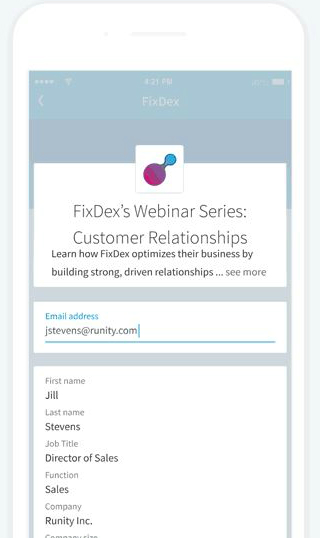by MGB2B

The Myth: More Leads Means More Conversions, and Thus More Profits
The Truth: Quality and Not Quantity Is What Leads to Conversions
Sure, it might seem like common sense. But how many times have you heard someone say “we’re just not getting enough leads coming in”? If you’ve heard this complaint once or twice – or perhaps you’ve complained about it yourself – you’ll want to read on about how to get quality leads over quantity. Often, it’s better to narrow your approach instead of casting a wider net and catching whatever happens to float in. By filtering out bad leads, you can increase your conversion rate, which is more important than having more leads.
To keep with the fishing metaphor, let’s say you’re only looking for red snapper. If you throw out your lines where snapper don’t usually swim, you’re going to catch a lot of fish that you don’t want and no snapper. Best to drop your line in the spots where snapper like to swim. You may only catch one or two, but you’ll get what you want. It’s as simple as that.
How to Get Quality B2B Leads:
- Tightly Define What a Quality Lead Means. Start with some buyer personas, to make sure all of your marketing efforts are targeted at the right people. But go beyond that. While there are many people who might fall under your buyer persona categories, you also need to examine their behavior. Perhaps a lead is someone who has spent time on your website and downloaded a particular piece of content like a white paper. Or maybe it’s someone who’s filled out a form on your website. You and your team need to agree on the criteria to determine what is considered a quality lead and not just a tire-kicker.
- Implement a Proper Paid Search Campaign. Paid Search is perhaps one of the most misused tools in the B2B marketing arsenal. When done properly, it can get the right leads through the right doors, and thus turn into an effective lead generation machine.
- Consider Retargeting Ads. Retargeting is when you serve up ads to people who visited your website, but the ads appear on other websites. Undoubtedly you’ve experienced this from other brands. A jacket you looked at on one site shows up on a news site your visiting. Or a hotel website you visited for your upcoming vacation serves you an ad on a blog you like to read. It’s not by accident that this is happening. It’s a highly effective tactic that works just as well for B2B brands as B2C.
- Partner with a Trade Publication Who Will Share Lists. Supplementing your own list of prospects with one from a trade pub is a smart approach to lead generation. Even if they won’t give you the list, they might allow you to send out an e-blast to either a portion or all of their subscribers if you already spend money on advertising opportunities with them. It’s a great way to keep your list growing with high quality leads.
- Score Those Leads. If you use CRM (customer relationship management) software, you most likely have the ability to score all leads that come in online (via website, social media, emails, online ads, etc.). They are scored based on a number of things including behavior, engagement, and demographics. And you can weight them however you like. So if Engineer is the most important job title you’re looking for, you can give that a higher score than other job titles. If you don’t want administrative staff to get into your sales funnel, you can give them a lower score.
- Look at Your Data Frequently. You can’t just set it and forget it. The data that comes from your campaigns will tell you what’s working and what’s not. And whether you use a CRM system or Google Analytics, or any other program to measure data, what you see happening each month can tell you quite a bit. You’ll discover which campaigns, search terms, and platforms are most effective.
- Refine Your Process Based on What the Data Is Telling You. Take what you learned from the previous step and rework each step to fine-tune your approach. Cut out what’s not working and test new things to make your marketing dollars work harder.
Again, the overarching goal is to increase your conversion rate. When it comes right down to it, what would you rather have: more fish in your net, or on your table?
Continue Reading
by MGB2B

Social media advertising is a valuable piece of your manufacturing company’s marketing program. It’s right up there more traditional media like in-person events and trade publications. And just like choosing trade shows or magazines to run ads in, social media channels depend on your brand, message, and budget. So, to help you along the way, we’ve evaluated Facebook, Twitter, and LinkedIn below. Take a look and determine which offer(s) the best social media ads for manufacturers based on campaign goals and budget.
Social Smackdown: The Best Social Media Ads for Manufacturers
Facebook
First up: the channel that is still largely believed to be a B2C only platform. While Facebook certainly falls on the more social side of social media, it has a whole host of B2B benefits. Facebook is a good place to highlight your company’s personality and culture through photos and videos. Imagine your target audience scrolling through their news feeds – what are they doing? Glancing at photos of friends and family, checking out local events, and reading articles related to their personal interests. So Facebook isn’t the ideal place to promote your highly technical white paper. But it is a great home for photos of your latest employee recognition night, holiday party, or trade show. When it comes to advertising on Facebook, here are a few things to keep in mind:
What Facebook Ads Are Good For:
- Growing your social media audience
- Recruiting talent
- Promoting content (blogs, infographics, videos)
What Facebook Ads Cost:
- Under $0.50 CPC (cost per click)
- Under $0.50 per like
To learn even more about what to expect with Facebook advertising, check out this guide from Buffer.
Twitter
Next up: Twitter, the micro-blogging channel often favored by manufacturers and B2C companies alike. Twitter has made rapid response a standard in social media customer service. Twitter is ideal for dropping a quick hook and pulling users onto your manufacturing website. Many users follow a combination of personal and professional accounts. Users are generally less put off by promotional messaging than they would be on Facebook. That being said, Twitter has become an advertising ocean where your message can easily get lost. Using attention-grabbing visuals and carefully built audiences can help your ads land in front of the right eyeballs.
What Twitter Ads Are Good For:
- Growing your social media audience
- Promoting content (blogs, articles, infographics)
- Building awareness
- Highlighting event attendance
- Launching new products
What Twitter Ads Cost:
- Around $1 CPC
- Under $2.50 per follower
To learn how to improve your Twitter ads (while they’re running), read this blog.
LinkedIn
As the social media network for professionals, LinkedIn fits right into many B2B social media strategies. Since profiles are tied to users’ professional identities, it’s more likely that their information is valid and up to date. Half of B2B buyers refer to LinkedIn when making purchase decisions. Running social media ads for manufacturers makes a lot of sense. Content like white papers, blog posts, and technical articles that didn’t work on Facebook are a great fit for LinkedIn. And, you can target users based on their job titles, functions, and seniority. But before you slap some ads up, here’s what you need to know:
What LinkedIn Ads Are Good For:
- Promoting content (white papers, technical guides, downloadable resources)
- Recruiting talent
- Building awareness
- Lead generation
What LinkedIn Ads Cost:
- CPC ranges between $3-$10
Including social media advertising in your marketing strategy can help your manufacturing company reach new audiences, share valuable content, gain leads and talent, and help support existing customers. Every campaign is different, as are the costs and benefits, but the guidelines above can help you begin to form a plan for your social strategy. Need help taking it to the next level? Drop us a line.
Continue Reading
by MGB2B
Two big product announcements have come out of LinkedIn over the past couple of months, one of which your manufacturing company can take advantage of right now. First, the leading social media network for professionals leaked that in November 2017, “Matched Audiences” will enable LinkedIn advertisers to target users based on their web activity and email addresses. And good timing – these options are already available on Twitter, Facebook, and other social sites. Unfortunately, you still have a few months to go before trying this particular feature. But here’s one you can put to use immediately. B2B companies, rejoice: there’s a new function currently available to LinkedIn advertisers: a LinkedIn lead generation tool.
 Just In Time
Just In Time
This roll out comes at an opportune time for LinkedIn, who is historically behind the ball when it comes to ad offerings. Twitter, the second most popular B2B social media channel for content distribution, has just sunset its lead generation ad format after several years of stagnancy. And while Facebook continues to offer a similar lead generation ad format, its use by 76% B2B organizations for content distribution pales in comparison to LinkedIn’s 89%. The professional social media network is in a rare position to lead the pack in, well, leads.
For now, the new LinkedIn lead gen ads are available on mobile devices only. And with almost 80% of social media time spent on mobile today, it’s not a bad move. (Though a desktop version will likely roll out eventually.) Thinking about getting started? Here are a few ways to use the new LinkedIn lead generation tool.
3 Ways to Use the New LinkedIn Lead Generation Tool
- White paper downloads. LinkedIn is effectively removing two steps from the traditional 3-step process of 1) advertising your white paper on LinkedIn, 2) directing users to a form fill page on your website, and 3) requiring users to fill out and submit a form to download. Now, users don’t need to leave the confines of LinkedIn to complete steps 2 and 3. And better yet, using their LinkedIn profile information, the form is largely autofilled.
- Webinar registrations. Like the example from this VentureBeat article, these lead gen ads give users a quick, easy way to sign up for online events like webinars. And LinkedIn content ads resemble regular posts – featuring social engagements right on the ad, including the ability to share. This social vote of confidence can work as extra incentive for users to sign up.
- Freebies. What if you could hand select which trade show visitors stopped by your booth for a branded lanyard? With LinkedIn ads, you can target based on demographics, down to which company users work for. And with new lead generation ads, you can offer these targeted users unique experiences and materials that will truly benefit their business, from consultations to a trial run of your product.
Most pieces of content that requires users to register for can be applied to the new LinkedIn lead generation tool. It’s important to remember, though, that until LinkedIn begins offering integrations with CRMs, you still need to download all collected leads from LinkedIn’s campaign manager. From there, they can be entered into your database and mailing list. Most importantly, into registering for whichever piece of content inspired them to click in the first place.
Can you see your company using this new LinkedIn lead generation tool? Need help getting started? Drop us a line.
Continue Reading


